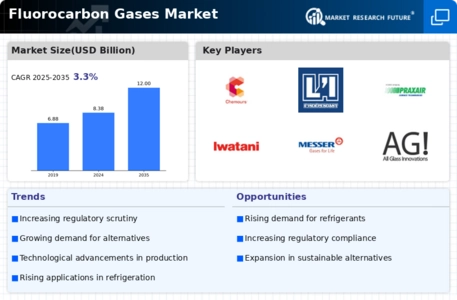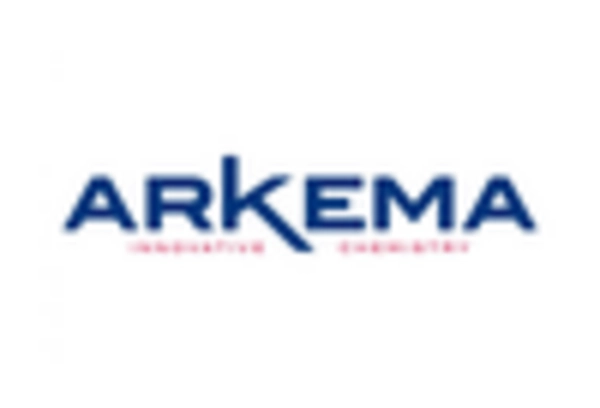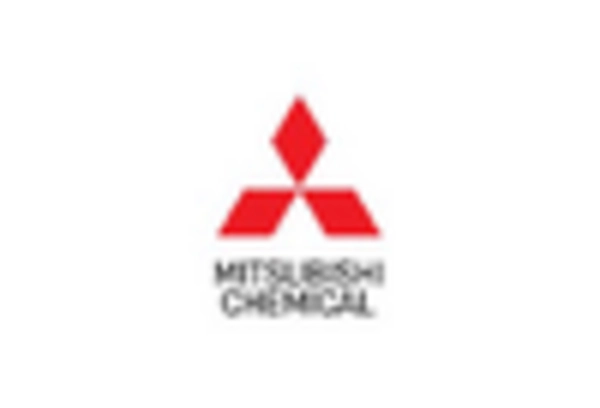Increased Focus on Energy Efficiency
Energy efficiency is becoming a central theme within the Fluorocarbon Gases Market, as both consumers and businesses seek to reduce energy consumption and associated costs. The transition towards energy-efficient systems, particularly in HVAC applications, is driving the adoption of advanced fluorocarbon gases that offer superior performance. Manufacturers are responding to this trend by developing products that not only meet regulatory standards but also enhance energy efficiency. This focus on efficiency is likely to lead to increased investments in research and development, as companies strive to create innovative solutions that align with market demands. Consequently, the emphasis on energy efficiency is expected to propel growth within the Fluorocarbon Gases Market.
Technological Innovations in Production
Technological advancements play a pivotal role in shaping the Fluorocarbon Gases Market. Innovations in production processes, such as the development of low-GWP alternatives and improved synthesis methods, are enhancing efficiency and reducing costs. For example, the introduction of new catalysts and reaction pathways has enabled manufacturers to produce fluorocarbon gases with lower environmental impact. Furthermore, advancements in recycling technologies are allowing for the recovery and reuse of fluorinated compounds, thereby minimizing waste. These technological improvements not only align with regulatory demands but also cater to the growing consumer preference for sustainable products, thus driving growth in the Fluorocarbon Gases Market.
Growing Applications in Specialty Chemicals
The Fluorocarbon Gases Market is witnessing an expansion in applications beyond traditional uses, particularly in the specialty chemicals sector. Fluorinated compounds are increasingly utilized in the production of high-performance materials, pharmaceuticals, and agrochemicals due to their unique properties. This diversification of applications is fostering new opportunities for growth, as industries seek to leverage the advantages of fluorocarbon gases in enhancing product performance. Market analysts indicate that the specialty chemicals segment is poised for significant growth, potentially outpacing other sectors. As a result, the Fluorocarbon Gases Market is likely to benefit from this trend, as manufacturers adapt their offerings to meet the evolving needs of various industries.
Regulatory Compliance and Environmental Standards
The Fluorocarbon Gases Market is increasingly influenced by stringent regulatory frameworks aimed at reducing greenhouse gas emissions. Governments worldwide are implementing policies that limit the use of high global warming potential gases, thereby driving demand for alternatives. For instance, the Kigali Amendment to the Montreal Protocol has set ambitious targets for phasing down hydrofluorocarbons (HFCs), which are prevalent in the fluorocarbon gases sector. This regulatory pressure compels manufacturers to innovate and adapt their product lines, fostering a shift towards more environmentally friendly options. As a result, companies that proactively comply with these regulations are likely to gain a competitive edge, positioning themselves favorably within the Fluorocarbon Gases Market.
Rising Demand in Refrigeration and Air Conditioning
The Fluorocarbon Gases Market is experiencing a surge in demand driven by the refrigeration and air conditioning sectors. As urbanization and population growth continue to rise, the need for efficient cooling solutions becomes increasingly critical. Fluorocarbon gases, particularly hydrofluorocarbons, are widely utilized in these applications due to their effective thermodynamic properties. According to industry reports, the refrigeration segment alone is projected to account for a substantial share of the market, with a compound annual growth rate of over 5% in the coming years. This growing demand underscores the importance of fluorocarbon gases in maintaining comfort and food preservation, thereby solidifying their role in the Fluorocarbon Gases Market.


















Leave a Comment